Remembrance Ride 2014
Sunday 9th November
On panel 10, high on the wall inside the Menin Gate at Ypres, is the name of a Canadian officer, Lieutenant A. H. Helmer. Helmer was 22 when he was killed on 2nd May 1915. His grave has been lost, disturbed by subsequent shelling. Helmer is commemorated on the Menin Gate along with 54,402 of his colleagues whose graves are not marked. His friend, Lt Col John McCrae, wrote the poem ‘In Flanders Fields’ in his memory; the legend holds that McCrae wrote it sitting upon the back of a field ambulance near the Advanced Dressing Station at Essex Farm, just to the north of Ypres. The poppy, which is the central motif of the poem, grows in profusion in disturbed earth because the seeds require a flash of light to promote germination. It seems that shellfire is perfect.
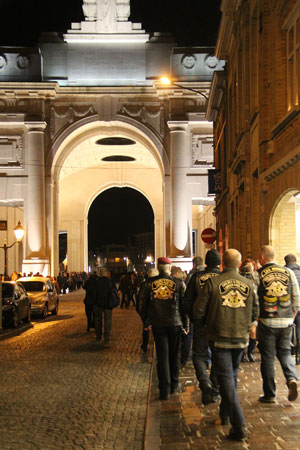
This incident formed the basis of C&F’s pilgrimage to Ypres to commemorate Remembrance Day in 2014, on the hundredth anniversary of the outbreak of the Great War.
On Sunday 9th we gathered at 611 Kings Road where the travellers observed the two minute silence (along with other chapter members who had come along to lend their support). We then had a ride briefing whilst Fred went home to get his passport. He did catch us up, but it apparently took 40 miles.
The route to Folkestone had to avoid any road closures, so there was no point in going anywhere near the Kings Road, Westminster etc. Les Channing had suggested the South Circular so after a quick recce it seemed feasible. In the event it worked OK and gave some North Londoners the opportunity of a close look at places like Forest Hill and Catford that they may have inadvertently missed. I doubt they’ll be back any time soon. The only sticky bit was a set of traffic lights on the Eltham by-pass, but never mind. As I joined the M20, a BMW saloon went past me like the proverbial bat out of hell, just as a marked traffic car came up on the on-slip on my left. I gladly waved the police car through, as he floored the throttle in pursuit of the show-off. Didn’t see them again.
The M20 was dull dull dull! But largely empty of traffic and with very few lorries, so we got to the Eurotunnel terminal in good time for people to explore the extensive take-out sandwich selection on offer.
After dismounting from the train at 4pm on the French side, first stop was for petrol for the two Sportsters and the V-Rod, plus a few other drought stricken travellers. It was 56 miles to Ypres and should take just over an hour, and it was due to get dark at 5pm. No hanging about and no cross-country heroics, it was off along the A16 towards Dunkirk. Just before we got to the Poperinghe turn-off I was overtaken by what I could only describe as a rat bike, followed closely by the Gendarmerie who seemed to be in convoy. A bit of agent provocateur perhaps? We were travelling in stately convoy at a steady 70 mph ready to proceed via the A19. We arrived in Ypres just as darkness was falling, and for the last few miles my mirrors had been full of all sorts and colours of Harley lighting. Is there an accessory lamp that Rob Warr hasn’t fitted to his CVO?
Once we reached the town square, it was a simple case of finding the correct hotels, checking in and then it was time for a few sherbets before walking to the Menin Gate for the Last Post ceremony. Every night since 1st July 1928, the buglers of the local volunteer fire service have played the Last Post to salute the Commonwealth dead commemorated on the memorial walls. (During the WW2 German occupation, the ceremony took place at Brookwood Cemetery near Woking (where we are going next year for Remembrance Sunday)). Because this was such an iconic occasion it was a full ceremony, with the buglers, a British police band, Scottish piper, a violinist playing antipodean folk tunes, a Canadian school choir, Royal British Legion standard bearers and torch bearer, and many wreaths being laid. Very emotional.

After the ceremony we walked thoughtfully through the town square admiring the stunning architecture of the rebuilt medieval Dutch town, before taking up a booking for 24 at Den Anker restaurant. Basically we had half the ground floor and for the next few hours kept the staff very busy keeping us supplied with beer (lots), wine (lots) and food (lots and lots). It worked out to a very reasonable 50 Euros a head (c. £40). We also had a collection for the Poppy Appeal, raising another 300 Euros (£220). Ride rockers were distributed to general acclaim.
The next morning, after a hearty hotel breakfast, we rendezvoused in the town square for a head count and briefing. All present and correct it was off to the nearest petrol station where we duly vanquished the Belgian credit card petrol pumps. A further 5 minutes up the road and we pulled in to Essex Farm Cemetery and Dressing Station. After a good look round, we decided to lay our wreath at the Stone of Remembrance as it was slightly more secluded from the coach-mounted hordes (it must be Belgium, it’s Monday) who were milling and trampling about. 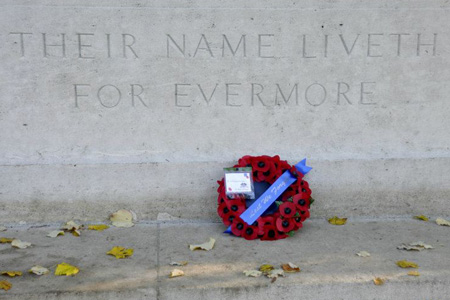 Gavin laid the wreath (calligraphy courtesy of Sarah Papas) and I then made a somewhat flawed attempt to read ‘In Flanders Fields’. A few moments of quiet reflection on the hideous scale of the losses incurred on all the participant nations in this most difficult of conflicts, and we were off to look at a preserved trench.
Gavin laid the wreath (calligraphy courtesy of Sarah Papas) and I then made a somewhat flawed attempt to read ‘In Flanders Fields’. A few moments of quiet reflection on the hideous scale of the losses incurred on all the participant nations in this most difficult of conflicts, and we were off to look at a preserved trench.
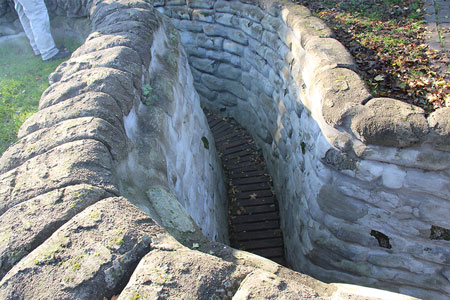
Manchester trench is in an industrial estate on the east bank of the Ypres-Yser canal (i.e. the side nearer the German lines). Because the British and Commonwealth armies were in the business of attacking to eject the Germans from Belgium and France, there was no point in sitting in safe seclusion dug into the west side of the spoil bank; they had to be over the other side, where it was wet, cold, muddy and dangerous. The trench itself was an eye opener; deep, narrow, wet and utterly comfortless. The thought of spending a couple of days in that standing up to your waist in cold muddy water without even a place to sit down was not conducive to happy thoughts.
We then drove slowly through the restored farmland, past several water-filled mine craters, up to the bleak and featureless ridge of Paschendale itself, the ultimate objective of the 1917 battles. From the windswept ‘summit’ it was a clear view back down to the towers of Ypres, together with an appreciation of the militarily difficult nature of the task of capturing it. Effectively no cover, and with the German machine guns stationed in pillboxes that were resistant to anything short of a direct hit from a large calibre shell, it is no surprise that the whole offensive (known as the Third Battle of Ypres) cost the Commonwealth armies somewhere in the region of 310,000 casualties, the Germans losing probably 260,000. However because of the calamitous mutinies in the French Armies after the failed Nivelle offensive on the Chemin des Dames in April 1917, there was little choice but to continue the fighting until the weather made further operations impossible. Tragic, immense and a source of national mourning were the casualty lists, unnecessary they were not; If the Germans had known the true state of the French army they could have climbed out of their trenches and virtually walked unopposed into Paris and ended the war in 1917
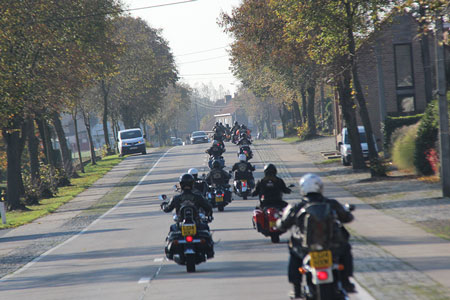
The pillboxes were thought to look a bit like Tyneside fishermen’s cottages, so the battlefield cemetery established on the ridge was named Tyne Cot. After the war, when the battlefield was combed over and again for temporary burials, the recovered bodies were concentrated into this cemetery, which now houses 11,953 burials, 8,366 of who are unknown. Their names are inscribed on the wall at the top of the cemetery; they just don’t know which body is which...
By this stage we were cemeteried out, so we gave Langemark (the Germans) a miss, and took the quick way back to Calais to the tunnel. The N8 to Veurne could not, using any usual meaning of the word, be called interesting. I didn’t feel too good on the motorway, so I pulled over and handed over to John Warr and Andrew Papas to take the group back to Calais, while I explored the coast road (and got a very useful ‘D’ for my ABCs at Dunkerque). Note to self: no point in wearing heated clothing if you leave the connector lead in the luggage bag.
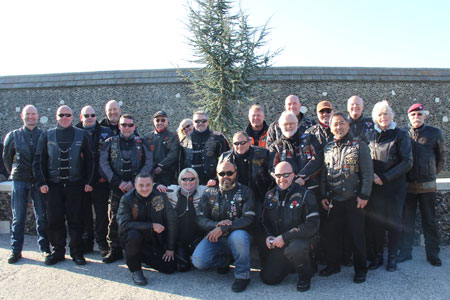
The Eurotunnel was largely deserted, so why did they split up the group onto different trains? When I got back on to the M20, I joined up with Les, Guy and the Joneses who had been moved from one virtually empty train to another one, so I had welcome company for the trip home.
Many thanks to: JW for Sunday breakfast, opening the shop and being very supportive throughout. Les and Andrew for last man duties. Gavin for laying the wreath, and Sarah for inscribing the label. Manuela, Keith, Rob and Guy for the usual splendid photographs. And to everyone else for sharing the experience, which was unique.
In 2015 we are going to the largest Commonwealth War Graves cemetery in the UK, at Brookwood. They know we’re coming...
Michael Howers, BA(Hons), MA - C&F Road Captain
Photographs by: Chelsea & Fulham’s Photographer Manuela De Castro, Keith Jones and Guy Ingram.
